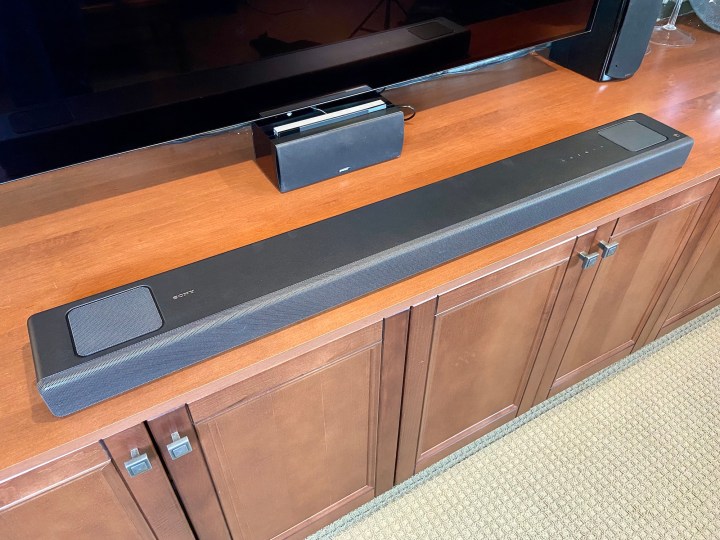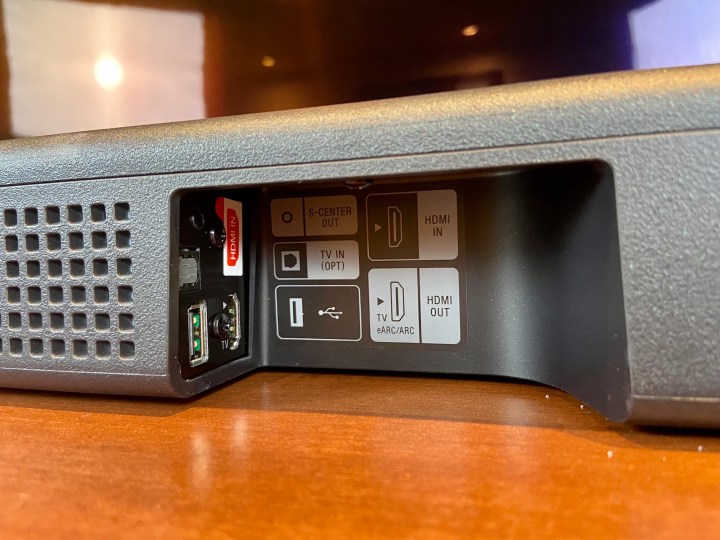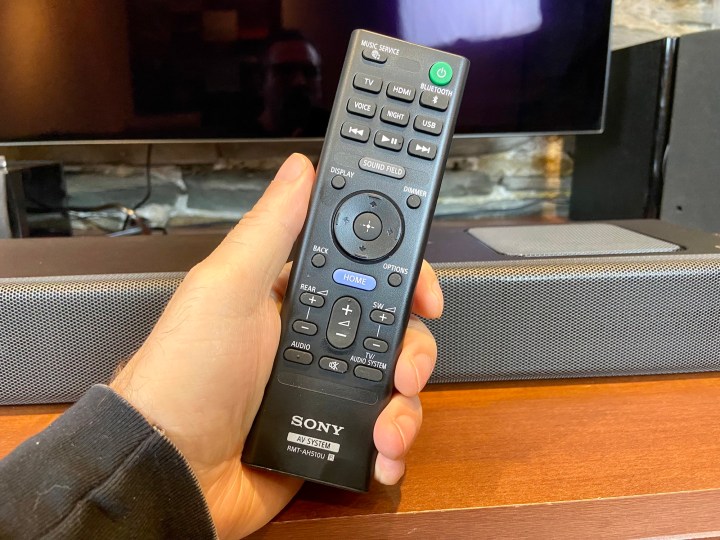- 8K-ready HDMI input
- Excellent movie and music sound
- Easy on-screen setup
- Tons of connection options
- Hi-res, Sony 360RA, and DTS:X
- No EQ adjustments
- Some settings are buried
- Poor integration of music services
At the higher end of the soundbar market, you’ll find great Dolby Atmos-compatible models like the $899 Sonos Arc, the $899 Bose Smart Soundbar 900, and LG’s $1,000 SP9YA. And now you can add Sony’s $1,000 HT-A5000 to that list. Wondering how it compares to the other models — and to Sony’s flagship $1,300 HT-A7000? Let’s check it out.
Big and basic

In terms of design the HT-A5000 (which we’ll simply call the A5000) isn’t much to look at. Absent are the glass top and fabric-wrapped speakers grilles of the HT-A7000, replaced instead with a simple textured black plastic body and grey metal speaker grilles. It won’t win any beauty pageants, but that’s a good thing. Personally, I think that soundbars shouldn’t call any attention to themselves visually, because that might detract from their primary purpose — to enhance the sound coming from your TV, which is where your eyes should be focused.
More important though, is the size. At 47.75 inches wide and 2.75 inches tall, the A5000 should have no problem finding a home in front of any but the smallest of TVs. Sony even claims that its Bravia TVs can accommodate the A5000 between their movable legs, but I don’t recommend doing that — any soundbar with up-firing speakers should be placed as far forward as possible, to give those drivers every opportunity to aim sound at your ceiling, unimpeded.
The HDMI input can handle 8K, Dolby Vision, and 4K at 120Hz, making it as future-proofed as it can be.
Sony also provides everything you could possibly need right in the box: Soundbar, wall-mount hardware, HDMI and optical cables, a remote control, and an analog patch cord for connecting a compatible Bravia TV. Yes — if you’re the lucky owner of one of Sony’s 2020 or 2021 Bravia TVs, you can use that cord to hijack the TV’s built-in speakers and have them enhance the soundbar’s center channel audio. Unfortunately, without one of those TVs on hand, I didn’t test this feature.
HDMI in, HDMI out, and 8K

Some soundbar companies (ahem, Sonos, Bose) think that a single HDMI ARC/eARC port should be enough for anyone. I don’t agree — and, thankfully, neither does Sony. The A5000 has both a dedicated HDMI input and an HDMI ARC/eARC input/output. Better yet, the HDMI input can passthrough 8K, Dolby Vision, and 4K at 120Hz signals to your TV, making it as future-proofed as it can be. There’s also an optical port if your TV doesn’t do HDMI ARC, but the A5000 drops the A7000’s analog input.
When it comes to the ways you can wirelessly connect to a speaker, the A5000 has them all covered.
Why does an HDMI input matter? Other than replacing the HDMI input on your TV you had to sacrifice for the soundbar’s connection, it gives those of us with older TVs the ability to connect Blu-ray players or streaming media devices directly to the soundbar. This gets around the inherent sound-quality limitations of HDMI ARC connections imposed by TVs that don’t have HDMI eARC. There’s quite a bit to unpack there, so instead of filling up space in this review with the full explanation, please check out our guides to HDMI ARC/eARC and Dolby Atmos. If you care about getting the best possible audio quality, you’ll thank me.
These ports are packed very tightly into a small recess on the back of the A5000, which makes them tricky to use, but as long as you don’t need to access them a lot, it shouldn’t cause you too much pain.
On-screen setup

Speaking of HDMI, the A5000 repeats one of my favorite features of the HT-A7000 — the on-screen setup process and menus. Not that using a smartphone app to set up a speaker is hard, but being able to use your TV’s screen while you kick back on your sofa, remote in hand, is way better.
From the initial connection to getting the A5000 onto your Wi-Fi network, to the zippy auto-room calibration procedure, Sony makes it easy and — dare I say it — fun. And at any time, you can choose to press the home button on the remote and navigate the soundbar’s menus on the screen, which is way more convenient than reading from the small scrolling digital display behind the speaker grille or pulling out your phone.
Connections galore

I’ve got to hand it to Sony. When it comes to the ways you can wirelessly connect to a speaker, the A5000 has them all covered. Bluetooth, Wi-Fi, AirPlay 2, Chromecast — pick your favorite. Even the Bluetooth connection, which on many soundbars is barely an afterthought, is impressive, with support for Sony’s LDAC codec so you can stream from an Android phone at the highest level of quality. You can also use LDAC for a high-quality wireless link to a compatible Bravia TV, should you want to go completely cable-free.
Thanks to exceptional support for high-quality wireless streaming, music generally sounds awesome.
These options mean that regardless of which phone you own, or which music streaming service you subscribe to, you’ll be able to get the most out of the A5000’s capabilities. And given the increasing support for lossless and hi-res audio from Apple Music, Amazon Music, Tidal, and others, these benefits are no longer theoretical edge cases.
Cleverly, Sony gives you the ability to switch the Bluetooth function from receive to transmit (again with LDAC support) so you can use any set of wireless headphones or earbuds for private listening.
Great for music, even better for movies

OK, down to business: How does this thing sound? Pretty damn good. If you stick with the A5000’s basic mode (keeping the Sound Field function turned off), you get perfectly clear and balanced stereo sound. It’s ideal for sitcoms, news broadcasts, and comedy specials — basically any time you want to focus on dialog. In this mode, even with the subwoofer set to max, bass remains gentle, providing just enough low-end to give voices added depth and some weight to the background soundtrack.
It’s also the preferred mode for listening to two-channel stereo music, especially if you’re a purist who wants to keep additional digital processing to a minimum. And thanks to the soundbar’s exceptional support for high-quality wireless streaming, music generally sounds awesome.
The only drawback is that if you don’t like the way Sony has tuned the A5000, there’s not much you can do about it. I dinged Sony for the lack of any EQ adjustments on its pricey A7000 and I’m going to do it again for the A5000. It’s a strange choice for a company that offers extensive EQ options for its wireless headphones and earbuds.
Dolby Atmos movies were all rendered with that key ingredient — sounds that seems to come from all around you.
If you have a Tidal HiFi or Amazon Music subscription, you owe it to yourself to try out tracks mastered using Sony’s 360 Reality Audio (360RA) format, which the A5000 supports. Simply put, 360RA attempts to mimic the sound of an indoor live performance by taking advantage of surround sound technology to give the music an open, airy feeling. As with Dolby Atmos Music, some tracks benefit from this more than others. Pink Floyd’s Learning To Fly, for instance, felt like it was made for 360RA, whereas John Mayer’s I Guess I Just Feel Like seemed to lose something in the transition.
But even when songs don’t necessarily benefit from 360RA, sometimes the format itself is preferable when you’re in the mood for a more ambient sound — say when entertaining a group of guests. I find it’s easier to carry on a conversation when the music isn’t being directed at you, as traditional stereo tends to do. For now, 360RA only works over a Wi-Fi Chromecast connection from a phone or tablet, so you won’t be able to control it via Amazon Alexa or Google Assistant.
The only drawback to the A5000’s musical prowess is the lack of music service integration into the Sony Music Center app. The app lists many of the most popular services (Apple Music, Amazon Music, Tidal, Spotify, Deezer, etc.), but tapping on these just pushes you out to the service’s app on your phone (assuming you have it installed). Unlike Sonos, there’s no way to access search, manage favorites or playlists, or any other music service feature. You can, however, use the app to control multiroom audio if you own other compatible Sony speakers.

You don’t buy a $1,000 Dolby Atmos soundbar for stereo sound. You want to be blown away by fully immersive 3D soundtracks that convey power, excitement, and emotion, and for that you need to engage Sound Field mode. Doing so immediately expands the soundstage from a fairly narrow and forward-facing affair to one that spreads around the room.
The A5000’s built-in subwoofer is surprisingly powerful. For smaller rooms, it’s probably all you need.
Sound Field mode isn’t one flavor of 3D, it’s three — Sony’s own Vertical Surround Engine, Dolby’s virtualized speaker mode, and DTS Virtual:X — and each has its own distinct sound signature. Sony’s version pulls back on low frequencies in favor of creating a tall, wide, and deep presentation that emphasizes clarity. Dolby, on the other hand, pushes the built-in subwoofer to its limits for a thunderous sound, but it can introduce unwanted distortion and often muddies the midrange and high frequencies. DTS Virtual:X is somewhere in between, but not in a Goldilocks way. It’s more of a compromise than that.
Because each of these 3D flavors sounds so different, they can all be good choices depending on what you’re playing. I found Sony’s version was ideal for native Dolby Atmos movies and music. Avengers: Infinity War, Mad Max: Fury Road, and Ford v. Ferrari were all rendered with that key Dolby Atmos ingredient — sounds that seem to come from all around you and move in sync with the on-screen action. Wondering if you’ll need one of Sony’s wireless subwoofers? They’d definitely give you better low-frequency effects, but the A5000’s built-in subwoofer is surprisingly powerful. For smaller rooms, it’s probably all you need.
I connected a Shield TV to the HDMI input and thoroughly enjoyed Dolby Atmos music tracks from Tidal like The Weeknd’s Save Your Tears and The Doors’ classic, Riders On The Storm. Dolby Atmos Music can feel lackluster at times, especially when using headphones, but the A5000 lets you appreciate the emerging format to its full potential.

But here’s a tip: As with most Dolby Atmos soundbars, if you feel like something’s missing — like you’re not really hearing an immersive mix — dive into the Advanced audio settings and boost the levels for the height and surround channels. Sony’s calibration software tends to take a conservative approach that doesn’t always yield the best results.
It’s definitely worth trying out Dolby’s virtualized speaker mode and DTS Virtual:X for all content, whether it’s Atmos or not, but switching between these 3D versions isn’t much fun. There’s no way to do it in the Sony Music Center app, and no way to do it by pressing a preset button on the remote.
Instead, you have to pause your movie or music, hit the Home button on the remote, and then navigate the on-screen menu to Setup > Advanced Setting > Audio Settings > Sound Field Settings. You can then choose a different 3D flavor and return to your content.
This might not be so bad if it was just a matter of finding the one you like most, but given there’s no way to tweak their EQ, switching between them is your only option if you don’t love the way one of them performs.
Beyond the bar

As with most mid-to-high-end soundbars, you can expand the A5000’s sonic chops by adding your choice of two Sony wireless subwoofers (SA-SW5 or SA-SW3), and a set of wireless surround satellites (SA-RS3S). Doing so doesn’t improve the system’s height channel prowess, but it can make a huge difference to the overall level of immersion. If you have the room in your home and in your budget, I highly recommend these additions.
Our take
Sony’s HT-A5000 commands a premium price, but it delivers a premium sound experience for both music and movie lovers.
Is there a better alternative?
At this price, the HT-A5000 has several direct competitors and they’re all excellent in their own way. Choosing among them really comes down to the features that matter to you. Here’s what you should know:
- If you’re an audiophile, the LG SP9YA is a strong contender because, like the A5000, it supports hi-res audio via Wi-Fi and USB. It also comes with its own wireless subwoofer, making it more satisfying for movies right out of the box. But it doesn’t support Bluetooth LDAC or Sony 360RA, and its hardwired power cord could be a nuisance for some installations.
- If you want easy and powerful control over your music sources and multiroom audio, and want some smart home extras, consider the Sonos Arc or the Bose Smart Soundbar 900. Neither have HDMI inputs, which reduces their flexibility, but that’s only a problem if you have an older TV. Both can serve as smart speakers with your choice of Amazon Alexa or Google Assistant.
- If you want a true home theater system replacement for movies and TV shows, but multiroom audio isn’t as important, the Vizio Elevate comes with a wireless subwoofer and surround satellite speakers, which usually cost extra.
- Want even better sound, but don’t want to clutter your room with more speakers? For $300 more, the Sony HT-A7000 is a bigger and more capable speaker (with two HDMI inputs plus an analog input) that is absolutely worth the extra investment.
How long will it last?
Sony’s products are very well-built and the HT-A5000 is no exception. When you consider its 8K compatibility, it could be 10 years or more before you even need to think about upgrading. And even then, it will be a choice, not a requirement.
Should you buy it?
Yes. The Sony HT-A5000 will be a tremendous movie and music upgrade for any TV room in the house.





